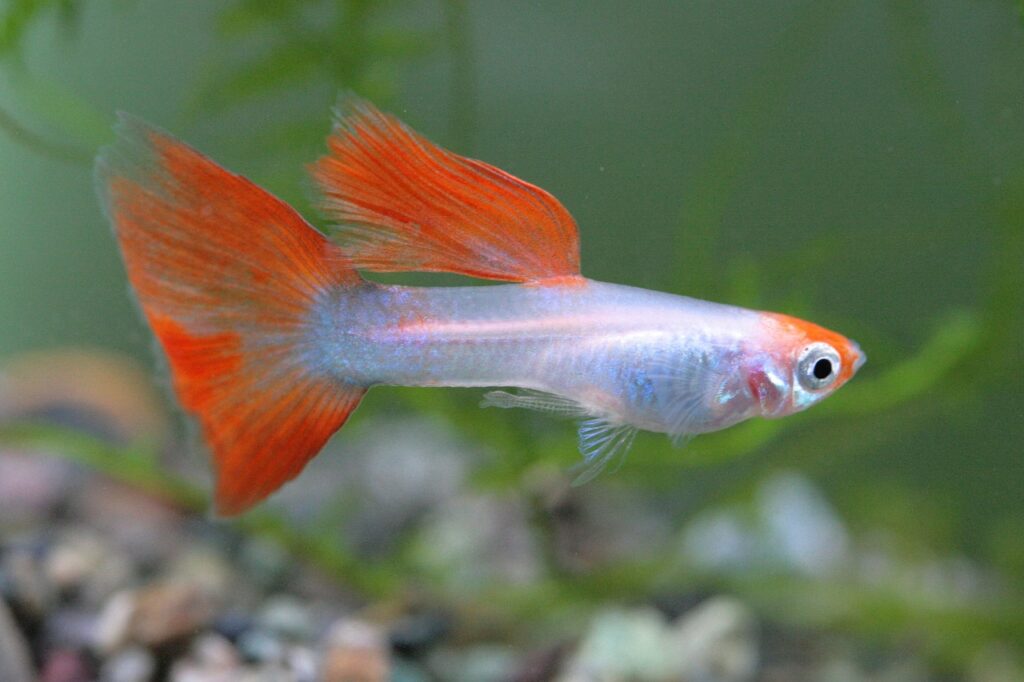Guppy fish change colors due to various factors, such as stress, environmental changes, aging, poor water quality, and insufficient diet. These color changes can be health indicators, and it is important to understand them to keep guppies healthy.
This article will explore the indicators of guppy aggression, red spots on the head, and the potential harm of ammonia poisoning. It will provide the reader with an understanding of color changes, indicators of health in guppy fish, and how to prevent problems.
Key Takeaways
- Guppy fish can change colors due to stress, environmental changes, aging, poor water quality, insufficient diet, and infection.
- Brightening colors in guppies are generally a positive sign, while paleness or color changes indicate potential health issues.
- Black eyes in guppies signal aggression towards other fish.
- A guppy’s tail turning black could indicate infection or high ammonia concentration in the tank.

Guppy Aggression Indicators
Black eyes in guppies may signal aggression towards other fish. Guppy behavior patterns can help us gain an understanding of guppy aggression.
Other indicators of this aggression include a guppy’s tail turning black, which could indicate infection. Additionally, a high concentration of ammonia in the fish tank can cause harm to a guppy’s tissues, leading to black patches on the fish.
It is important to understand the effects of ammonia on fish, as even small amounts can be damaging. Ammonia levels may quickly rise in a new tank if it hasn’t been fully cycled or if too many fish have been added too quickly.
Prevention is preferable to treatment, and it is important to understand guppy behavior patterns to understand their aggression better.
Red Spots on the Head
Red spots on a fish’s head may result from ammonia poisoning. This can occur when the pH level in the fish tank is elevated and can be harmful even in small amounts. Poor water quality, insufficient diet, infection, and aging can also cause color changes in guppies.
Taking care of our aquatic friends is important, as their health and well-being is essential to their survival. To serve them better, we must be aware of the signs of illness, such as:
- Red spots
- Ammonia poisoning
- Changes in environment
- Color changes
- Brightening colors
- Pale patches or color changes

Ammonia and Harm
Ammonia poisoning can quickly occur in new tanks due to the lack of beneficial bacteria; even small amounts can harm fish. To prevent ammonia poisoning, conducting a full water test to check ammonia levels before adding fish to a tank is important.
High ammonia levels can damage guppy’s tissues, cause black patches, and result in red spots on the head.
Additionally, it can cause gasping at the surface and reddish gills, which are all indicators of ammonia poisoning. To ensure the health of the fish, it is important to keep the pH level in the tank at an appropriate level and avoid overcrowding. Taking these precautions will help avoid the harmful effects of high ammonia levels on fish health.
| Causes | Symptoms | Prevention |
|---|---|---|
| Lack of beneficial bacteria | Black patches/red spots | Conduct full water test |
| High ammonia levels | Gasping at surface/reddish gills | Conduct a full water test |
| Overcrowding | Avoid overcrowding |
Frequently Asked Questions
Conclusion
In conclusion, guppy fish can change colors for various reasons, from stress to infection. Understanding the various indicators of guppy health and color changes is important to keep them healthy.
Black eyes can indicate aggression between guppies, and red spots on the head may result from ammonia poisoning, which can occur when the pH level in the tank is elevated or when adding too many fish too quickly. Even small amounts of ammonia can be harmful, making it important to prevent ammonia poisoning rather than treat it.
Brightening colors are usually a good sign, while paleness or other color changes indicate a problem.
